Fuel Consumption and Emission Reduction for Non-Road Diesel Engines with Electrically Heated Catalysts
Abstract
1. Introduction
2. Result and Discussion
2.1. The Effect of UWS Injection Start Temperature and NSR Map on NOx Emissions
- One was to set the injection start temperature to 200 °C based on the DPF outlet exhaust temperature, which is equivalent to an SCR inlet temperature of 150 °C, and create an NSR map (Figure 2-(III)).
- The second was to set the injection start temperature to 175 °C at the SCR inlet (Figure 2-(II)).
- The third was to set the injection start temperature based on 200 °C (Figure 2-(I)).
2.2. The Effect of Electrical Heating Power and Duration on NOx Emissions
2.3. NH3, N2O, and PM Emission According to Oxidation Catalysts
2.4. Equivalent Fuel Penalty
3. Experimental Setup
3.1. Engine and Aftertreatment System
3.2. Preparation of Electrical Heated Catalyst
3.3. Experimental Setup
3.4. SCR System Operation Control Configuration
4. Conclusions
Author Contributions
Funding
Data Availability Statement
Conflicts of Interest
References
- Kamimoto, T.; Bae, M. High Combustion Temperature for the Reduction of Particulate in Diesel Engines; SAE Technical Paper 880423; SAE International: Warrendale, PA, USA, 1988; Volume 97, pp. 692–701. [Google Scholar] [CrossRef]
- Shim, E.J.; Park, H.; Bae, C. Effects of Hot and Cooled EGR for HC Reduction in a Dual-Fuel Premixed Charge Compression Ignition Engine; SAE Technical Paper 0148-7191; SAE International: Warrendale, PA, USA, 2018. [Google Scholar] [CrossRef]
- Wang, B. Autoignition of light naphtha and its surrogates in a rapid compression machine. Energy Sci. Eng. 2019, 7, 207–216. [Google Scholar] [CrossRef]
- Li, X.; Gao, H.; Zhao, L.; Zhang, Z.; He, X.; Liu, F. Combustion and emission performance of a split injection diesel engine in a double swirl combustion system. Energy 2016, 114, 1135–1146. [Google Scholar] [CrossRef]
- Langridge, S.; Fessler, H. Strategies for High EGR Rates in a Diesel Engine; SAE Technical Paper 2002-01-0961; SAE International: Warrendale, PA, USA, 2002. [Google Scholar] [CrossRef]
- Jeong, B.G.; Won, J.H.; Oh, K.C.; Heo, H.S.; Bae, S.; Seo, H.J.; Kim, H. Characteristics of Integrated Air Control and Low-Pressure Exhaust Gas Recirculation Valve for Diesel Engines. Int. J. Automot. Technol. 2020, 21, 239–247. [Google Scholar] [CrossRef]
- Elkelawy, M.; El Shenawy, E.A.; Mohamed, S.A.; Elarabi, M.M.; Alm-Eldin Bastawissi, H. Impacts of EGR on RCCI engines management: A comprehensive review. Energy Convers. Manag. X 2022, 14, 100216. [Google Scholar] [CrossRef]
- Andreata, M.; Millo, F.; Mallamo, F.; Mercuri, D.; Pozzi, C. Experimental Investigation on Three Different Ceramic Substrate Materials for a Diesel Particulate Filter; SAE Technical Paper 2013-24-0160; SAE International: Warrendale, PA, USA, 2013. [Google Scholar] [CrossRef]
- Lee, K.; Kim, S.; Oh, K.C. The Effect of Pore Structure on Thermal Characteristics of a Cordierite Diesel Particulate Filter for Heavy Duty Diesel Vehicle. Int. J. Automot. Technol. 2021, 22, 243–251. [Google Scholar] [CrossRef]
- Oh, K.C.; Lee, K.B.; Jeong, B.G. Characteristics of Resistive PM Sensors for Onboard Diagnostics of Diesel Particulate Filter Failure. Sensors 2022, 22, 3767. [Google Scholar] [CrossRef]
- Joshi, A. Review of vehicle engine efficiency and emissions. SAE Int. J. Adv. Curr. Pract. Mobil. 2020, 2, 2479–2507. [Google Scholar] [CrossRef]
- Ko, S.C.; Oh, K.C.; Seo, C.K.; Lee, C.B. Characteristics on NOx adsorption and intermediates of LNT catalyst. Int. J. Automot. Technol. 2014, 15, 347–352. [Google Scholar] [CrossRef]
- Lee, K.; Choi, B.; Kim, C.; Lee, C.; Oh, K. De-NOx characteristics of HC-SCR system employing combined Ag/Al2O3 and CuSn/ZSM-5 catalyst. J. Ind. Eng. Chem. 2021, 93, 461–475. [Google Scholar] [CrossRef]
- Dev, S.; Guo, H.; Liko, B.; Lafrance, S.; Conde, A. An Experimental Study on NOx Emissions of a Heavy-Duty Diesel Engine during Cold Start and Idling; SAE Technical Paper 2021-01-0535; SAE International: Warrendale, PA, USA, 2021. [Google Scholar] [CrossRef]
- Preble, C.V.; Harley, R.A.; Kirchstetter, T.W. Control Technology-Driven Changes to In-Use Heavy-Duty Diesel Truck Emissions of Nitrogenous Species and Related Environmental Impacts. Environ. Sci. Technol. 2019, 53, 14568–14576. [Google Scholar] [CrossRef]
- Wardana, M.K.A.; Oh, K.; Lim, O. Investigation of Urea Uniformity with Different Types of Urea Injectors in an SCR System. Catalysts 2020, 10, 1269. [Google Scholar] [CrossRef]
- Jeong, B.G.; Oh, K.C.; Jang, S.U. Melting and Heat Transfer Characteristics of Urea Water Solution According to a Heating Module’s Operating Conditions in a Frozen Urea Tank. Energies 2021, 14, 8164. [Google Scholar] [CrossRef]
- Joshi, A. Review of Vehicle Engine Efficiency and Emissions. SAE Int. J. Adv. Curr. Pract. Mobil. 2022, 4, 1704–1733. [Google Scholar] [CrossRef]
- Dallmann, T.; Shao, Z.; Menon, A.; Bandivadekar, A. Non-Road Engine Technology Pathways and Emissions Projections for the Indian Agricultural and Construction Sectors; SAE Technical Paper 2017-26-0230; SAE International: Warrendale, PA, USA, 2017. [Google Scholar] [CrossRef]
- Nova, I.; Tronconi, E. Urea-SCR Technology for deNOx after Treatment of Diesel Exhausts; Springer: New York, NY, USA, 2014; Volume 5. [Google Scholar] [CrossRef]
- Wang, T.J. Effects of insulation on exhaust temperature and subsequent SCR efficiency of a heavy-duty diesel engine. J. Mech. Sci. Technol. 2019, 33, 923–929. [Google Scholar] [CrossRef]
- Avolio, G.; Brück, R.; Grimm, J.; Maiwald, O.; Rösel, G.; Zhang, H. Super clean electrified diesel: Towards real NOx emissions below 35 mg/km. In Proceedings of the 27th Aachen Colloquium Automobile and Engine Technology, Aachen, Germany, 8–10 October 2018. [Google Scholar]
- Samaras, Z.; Kontses, A.; Dimaratos, A.; Kontses, D.; Balazs, A.; Hausberger, S.; Ntziachristos, L.; Andersson, J.; Ligterink, N.; Aakko-Saksa, P.; et al. A European Regulatory Perspective towards a Euro 7 Proposal; SAE Technical Paper 2022-37-0032; SAE International: Warrendale, PA, USA, 2022. [Google Scholar] [CrossRef]
- Dallmann, T.; Menon, A. Technology Pathways for Diesel Engines Used in Non-Road Vehicles and Equipment; International Council on Clean Transportation (ICCT): Washington, DC, USA, 2016. [Google Scholar]
- CARB Developing Tier 5 Emission Standards for Off-Road Engines. Available online: https://dieselnet.com/news/2021/11carb.php (accessed on 1 April 2022).
- Moon, S.; Park, S.; Son, J.; Oh, K.; Jang, S. Simplified Modeling and Analysis of Surface Temperature Distribution in Electrically Heated Catalyst for Diesel Urea-SCR Systems. Energies 2022, 15, 6406. [Google Scholar] [CrossRef]
- Raza, H.; Oh, K.C.; Kim, H. The effect of ammonia gas and UWS injection on the N2O formation in diesel engine after-treatment systems under steady and transient conditions. Fuel 2022, 330, 125657. [Google Scholar] [CrossRef]
- Lyu, L.; Sun, W.; Feng, P.; Wang, H.; Hao, L.; Tan, J.; Wang, X.; Song, C.; Li, H.; Li, Z.; et al. NH3 and N2O emission durability of the heavy-duty diesel engine with DOC, DPF, SCR, and ASC through the accelerated aging method. Fuel 2023, 339, 126950. [Google Scholar] [CrossRef]
- Duan, L.; Tan, P.; Liu, J.; Liu, Y.; Chen, Y.; Lou, D.; Hu, Z. Emission characteristics of a diesel engine with an electrically heated catalyst under cold start conditions. J. Clean. Prod. 2022, 380, 134965. [Google Scholar] [CrossRef]
- Hu, J.; Wu, Y.; Liao, J.; Cai, Z.; Yu, Q. Heating and storage: A review on exhaust thermal management applications for a better trade-off between environment and economy in ICEs. Appl. Therm. Eng. 2023, 220, 119782. [Google Scholar] [CrossRef]
- Nie, X.; Bi, Y.; Liu, S.; Shen, L.; Wan, M. Impacts of different exhaust thermal management methods on diesel engine and SCR performance at different altitude levels. Fuel 2022, 324, 124747. [Google Scholar] [CrossRef]
- Cavina, N.; Mancini, G.; Corti, E.; Moro, D.; De Cesare, M.; Stola, F. Thermal Management Strategies for SCR after Treatment Systems.; SAE Technical Paper 2013-24-0153; SAE International: Warrendale, PA, USA, 2013. [Google Scholar] [CrossRef]
- McCarthy, J.J.; Matheaus, A.; Zavala, B.; Sharp, C.; Harris, T. Meeting Future NOx Emissions Over Various Cycles Using a Fuel Burner and Conventional Aftertreatment System. SAE Int. J. Adv. Curr. Pract. Mobil. 2022, 4, 2220–2234. [Google Scholar] [CrossRef]
- Kim, C.H.; Paratore, M.; Gonze, E.; Solbrig, C.; Smith, S. Electrically Heated Catalysts for Cold-Start Emissions in Diesel Aftertreatment; SAE Technical Paper 2012-01-1092; SAE International: Warrendale, PA, USA, 2012. [Google Scholar] [CrossRef]
- Laurell, M.; Pace, L.; Ekström, F.; Konieczny, K. Strive for Zero Emissions Impact from Hybrids; SAE Technical Paper 2019-24-0146; SAE International: Warrendale, PA, USA, 2019. [Google Scholar] [CrossRef]
- Hofstetter, J.; Boucharel, P.; Atzler, F.; Wachtmeister, G. Fuel Consumption and Emission Reduction for Hybrid Electric Vehicles with Electrically Heated Catalyst. SAE Int. J. Adv. Curr. Pract. Mobil. 2020, 3, 702–714. [Google Scholar] [CrossRef]
- Sadamitsu, T.; Oki, T.; Korenaga, S.; Hirooka, S.; Iwasaki, S.; Iida, T. Development of a Ceramic EHC. SAE Int. J. Adv. Curr. Pract. Mobil. 2022, 5, 141–147. [Google Scholar] [CrossRef]
- Lee, C.; Oh, K.; Kim, D.; Lee, C. A Characteristics of Particle Number Distribution for the Urea Solution Injection to Urea SCR System of Commercial Diesel Engine for an Emission Regulation; SAE Technical Paper 2007-01-3455; SAE International: Warrendale, PA, USA, 2007. [Google Scholar] [CrossRef]
- Zhu, Y.; Hou, Q.; Shreka, M.; Yuan, L.; Zhou, S.; Feng, Y.; Xia, C. Ammonium-Salt Formation and Catalyst Deactivation in the SCR System for a Marine Diesel Engine. Catalysts 2018, 9, 21. [Google Scholar] [CrossRef]
- Colombo, M.; Nova, I.; Tronconi, E. Detailed kinetic modeling of the NH3-NO/NO2 SCR reactions over a commercial Cu-zeolite catalyst for Diesel exhausts after treatment. Catal. Today 2012, 197, 243–255. [Google Scholar] [CrossRef]
- Bendrich, M.; Scheuer, A.; Hayes, R.; Votsmeier, M. Increased SCR performance of Cu-CHA due to ammonium nitrate buffer: Experiments with oscillating NO/NO2 ratios and application to real driving cycles. Appl. Catal. B Environ. 2020, 270, 118763. [Google Scholar] [CrossRef]
- Zhang, D.; Yang, R.T. N2O formation pathways over zeolite-supported Cu and Fe catalysts in NH3-SCR. Energy Fuels 2018, 32, 2170–2182. [Google Scholar] [CrossRef]
- Strots, V.O.; Santhanam, S.; Adelman, B.J.; Griffin, G.A.; Derybowski, E.M. Deposit formation in urea-SCR systems. SAE Int. J. Fuels Lubr. 2010, 2, 283–289. [Google Scholar] [CrossRef]
- Jung, S.C.; Yoon, W.S. Unified Modeling and Performance Prediction of Diesel NOx and PM Reduction by DOC-DPF-SCR System. Trans. Korean Soc. Automot. Eng. 2008, 16, 110–119. [Google Scholar]
- Yao, D.; Liu, B.; Wu, F.; Li, Y.; Hu, X.; Jin, W.; Wang, X. N2O formation mechanism during low-temperature NH3-SCR over Cu-SSZ-13 catalysts with different Cu loadings. Ind. Eng. Chem. Res. 2021, 60, 10083–10093. [Google Scholar] [CrossRef]
- Bezaire, B.A. Modeling and Control of an Electrically-Heated Catalyst. Master’s Thesis, The Ohio State University, Columbus, OH, USA, 2011. [Google Scholar]
- Oh, K.; Seo, C.K.; Go, S. Commercialization research of a metal DOC based on Fe-Cr-Ni substrate. Chem. Eng. J. 2014, 254, 426–433. [Google Scholar] [CrossRef]
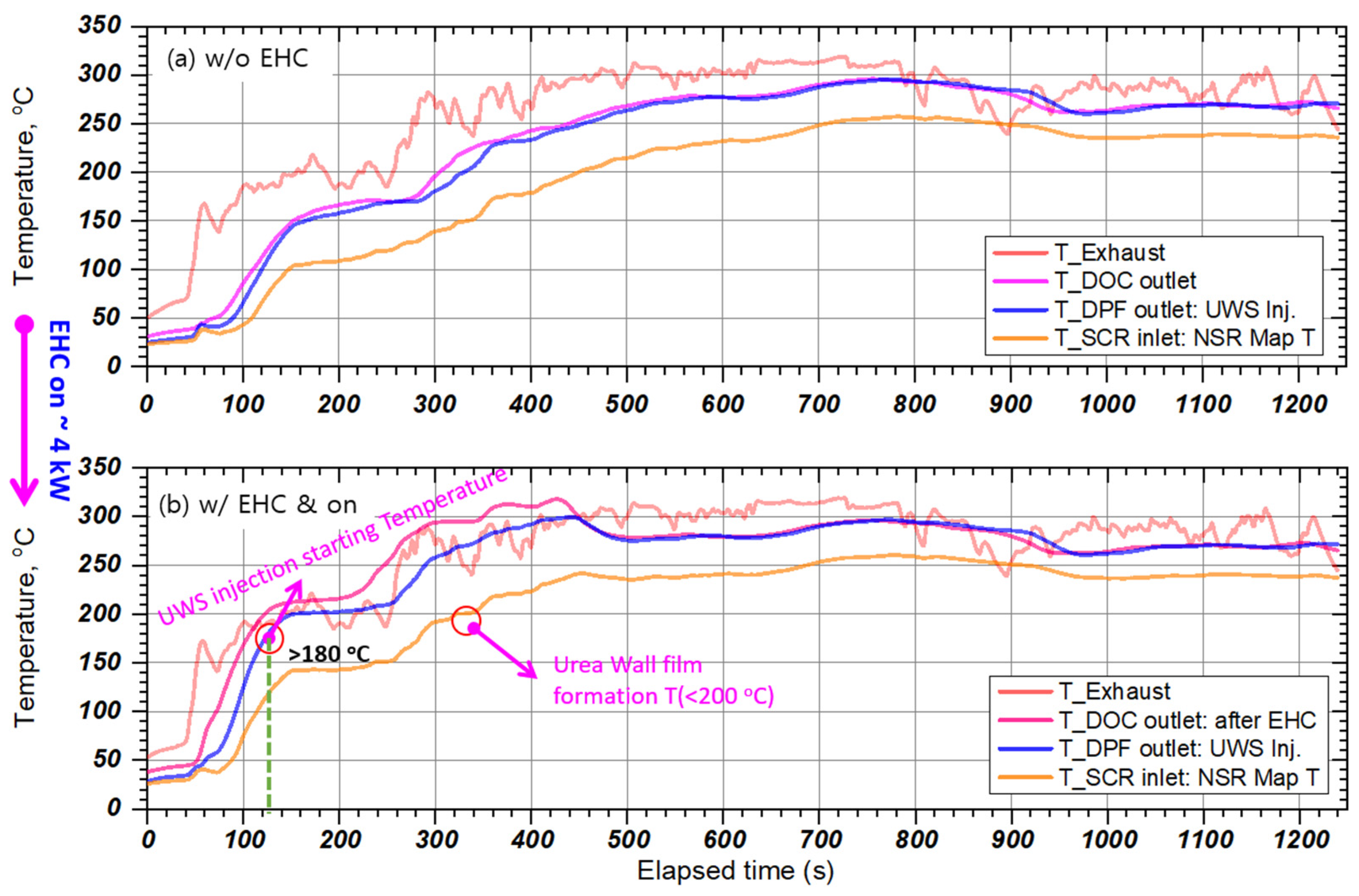
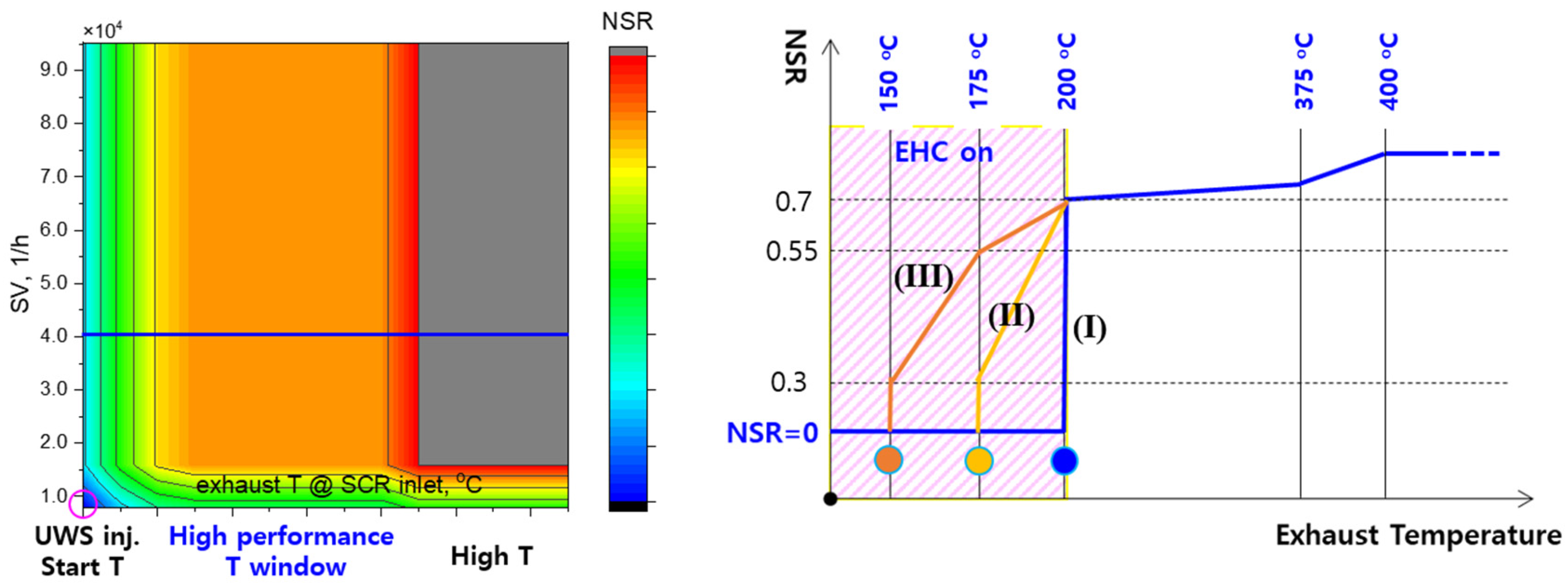
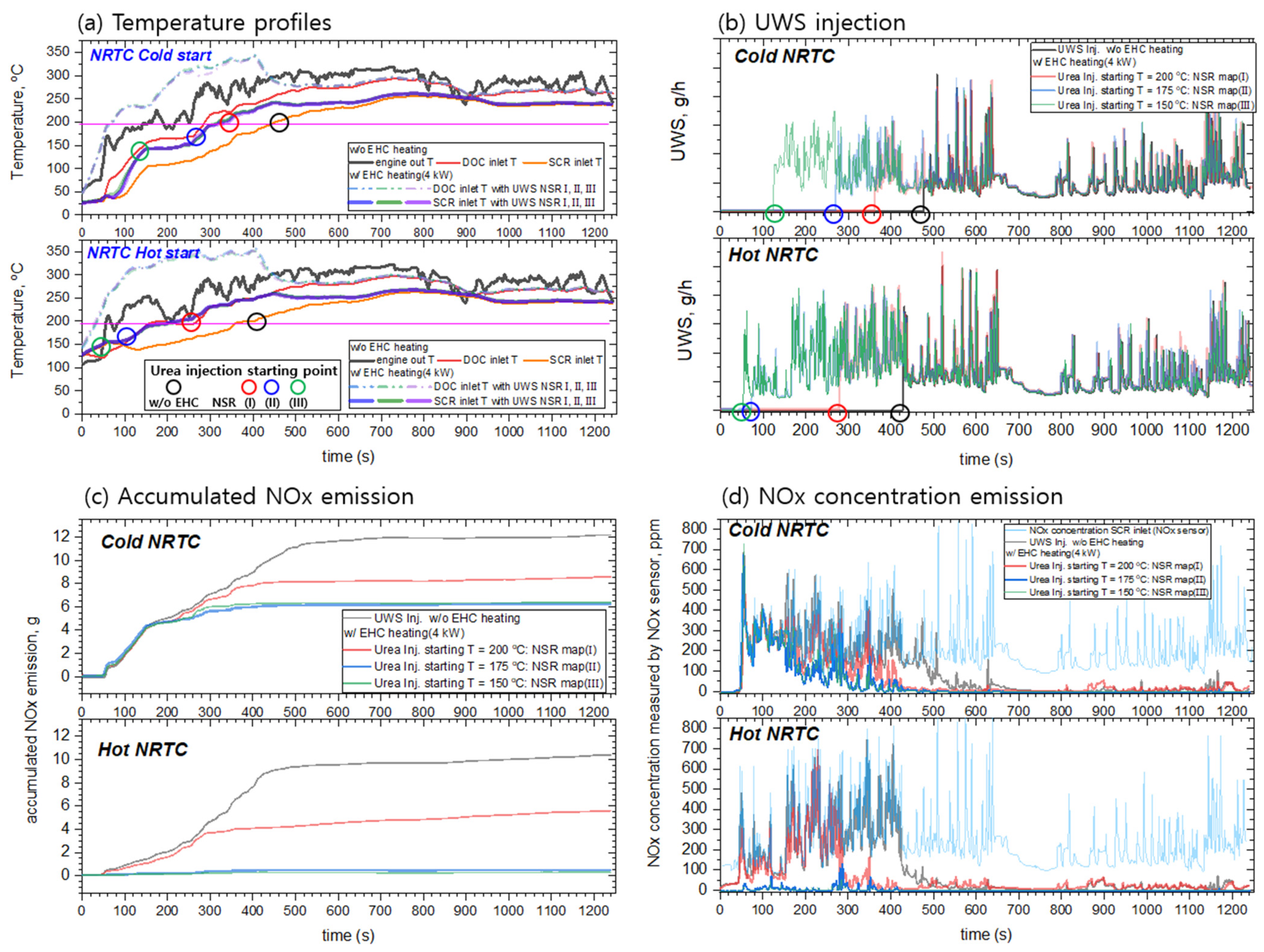
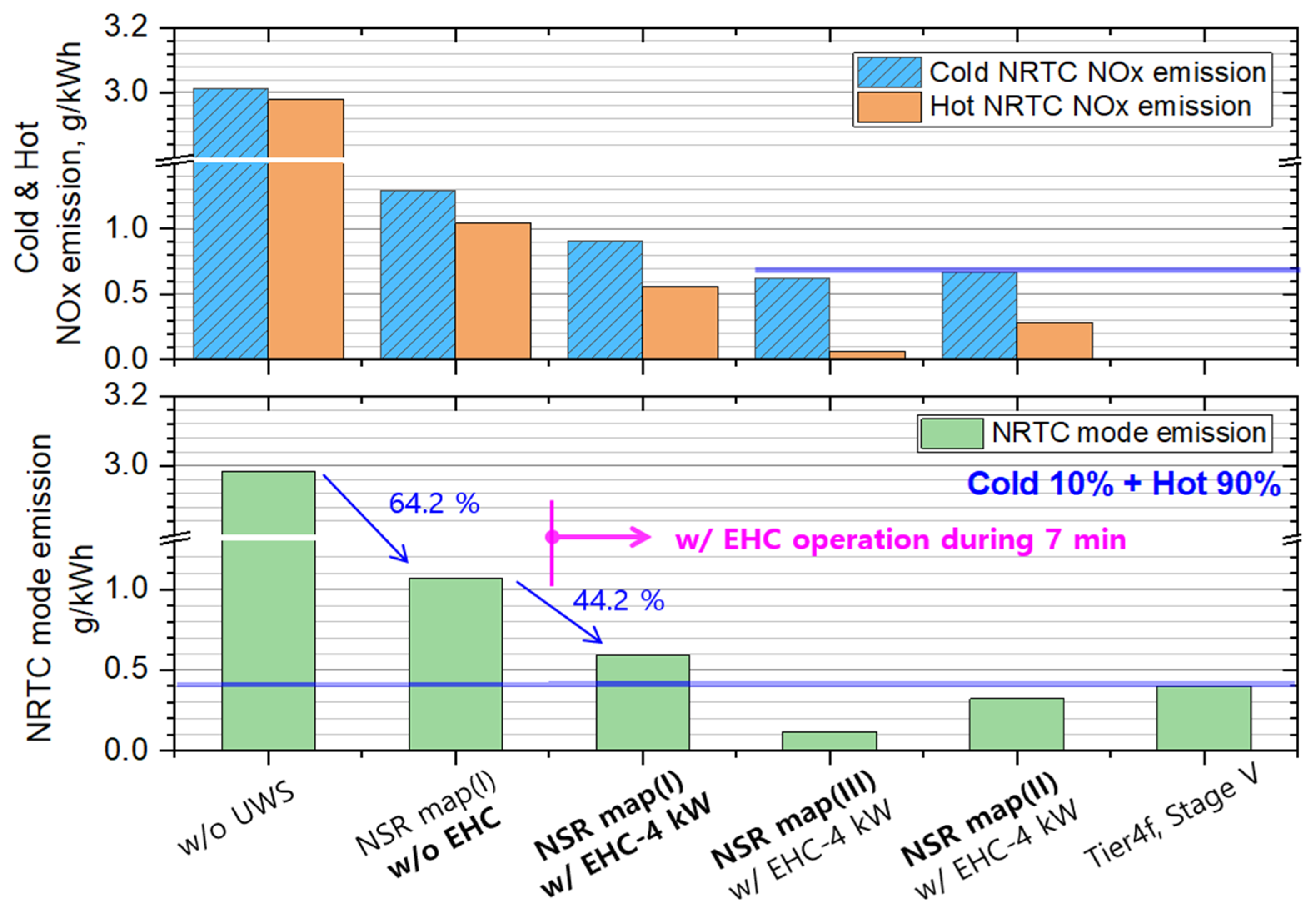

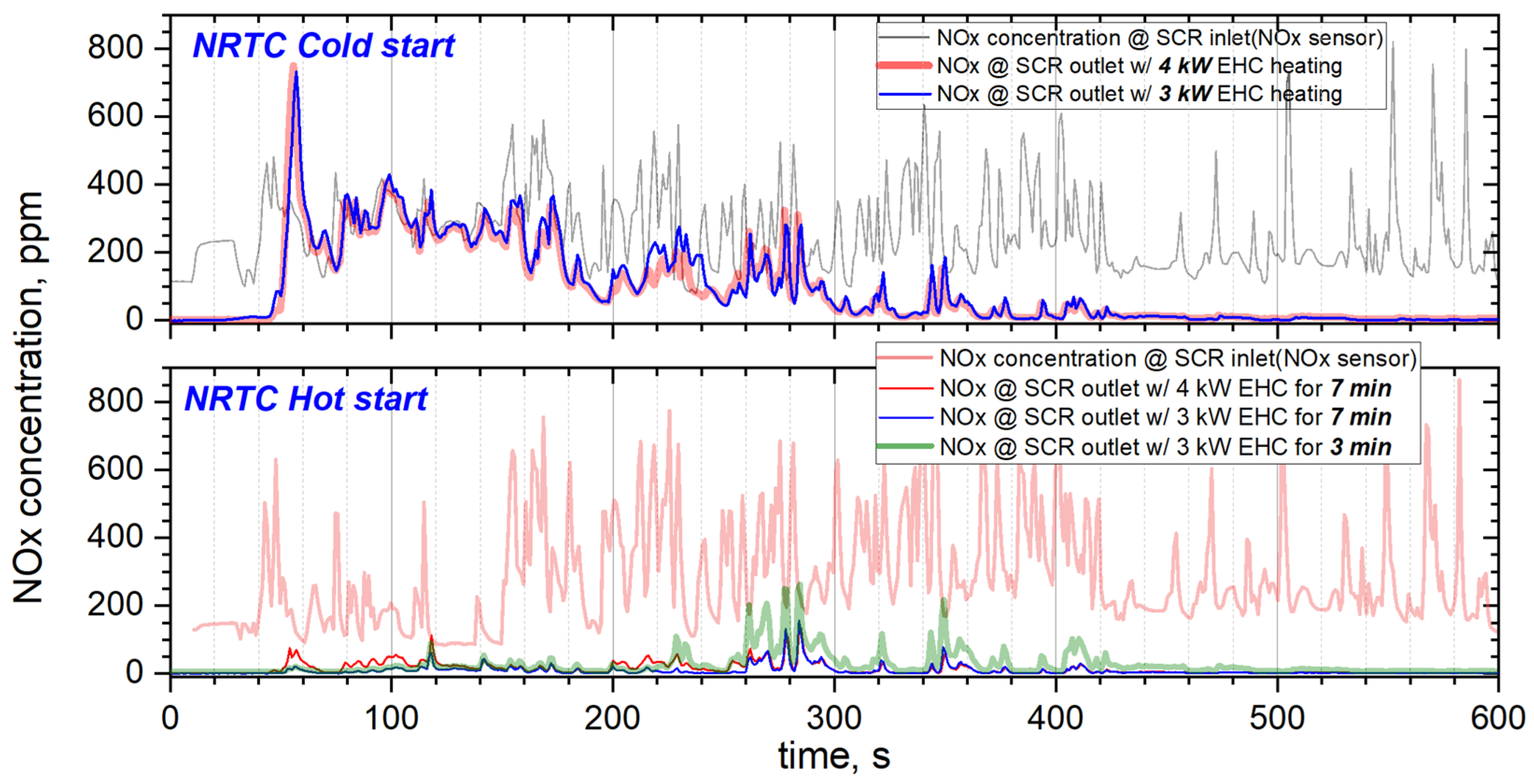
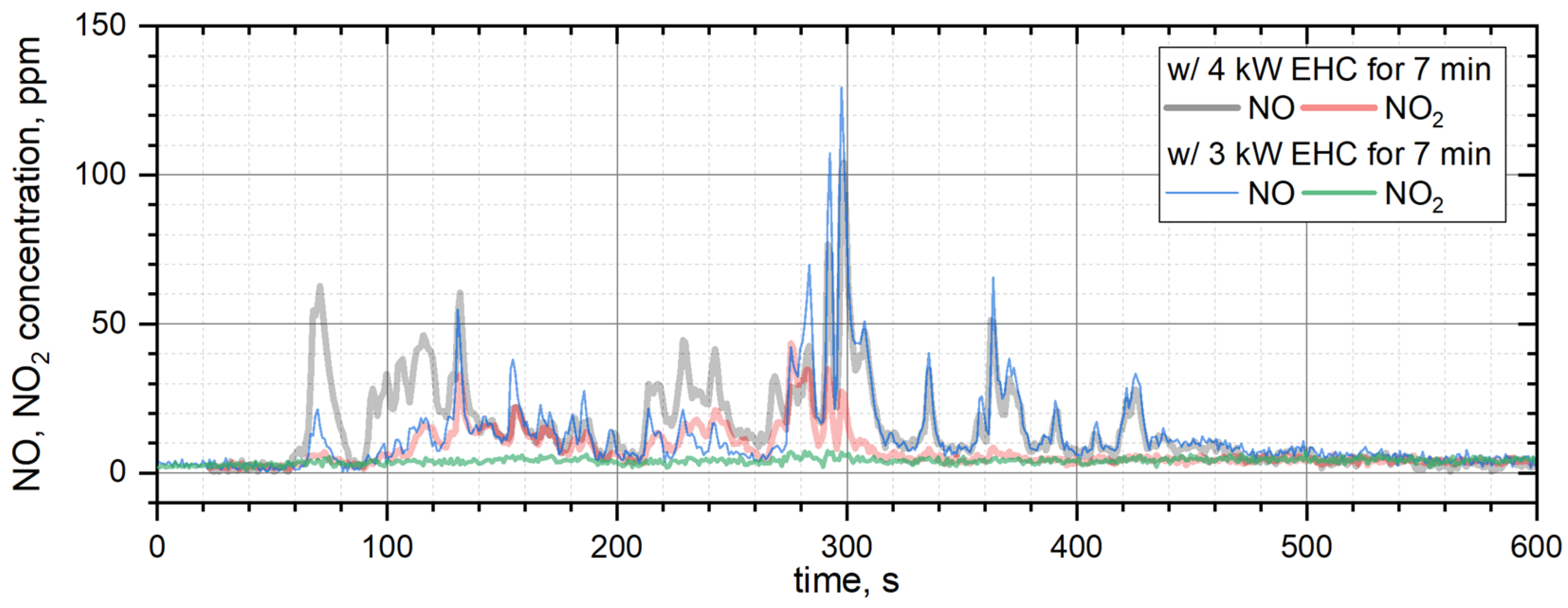
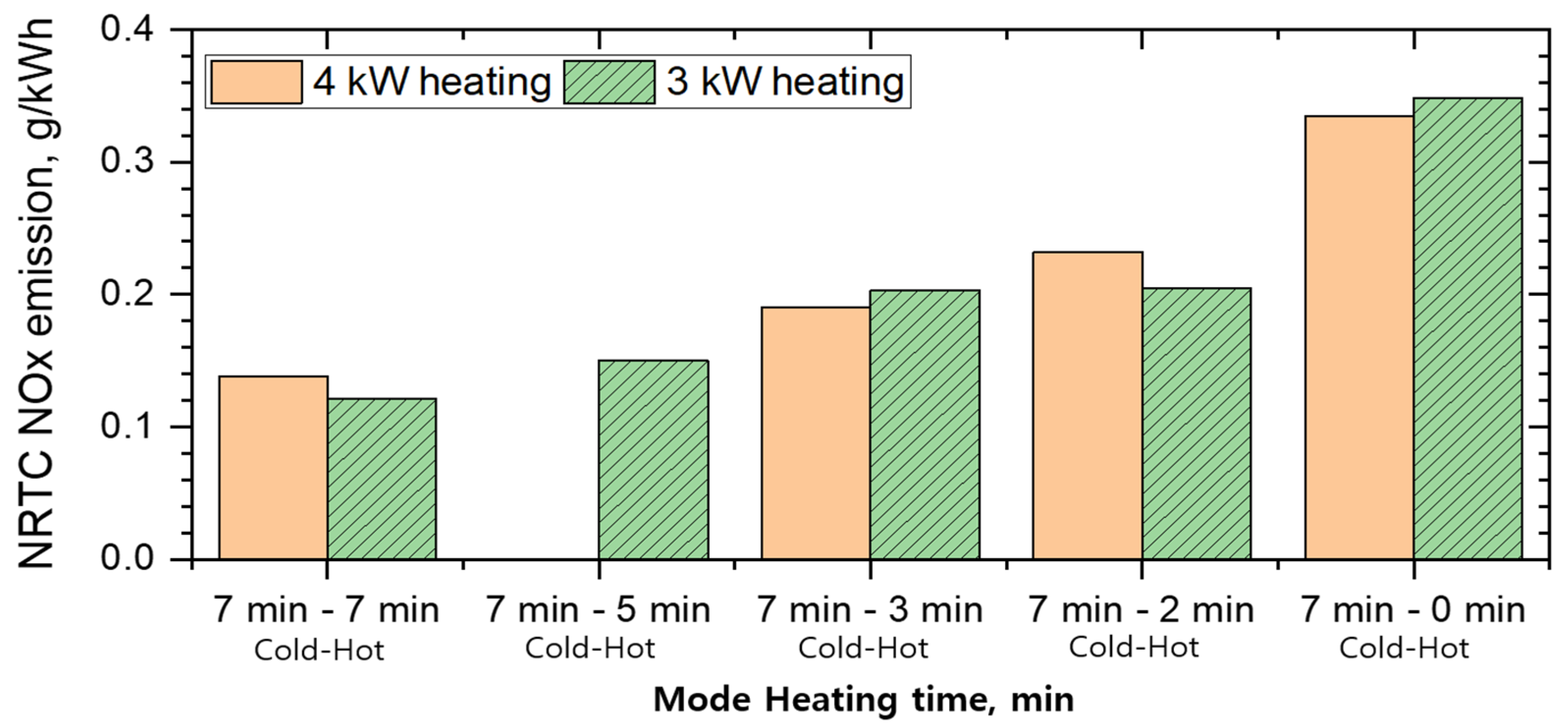
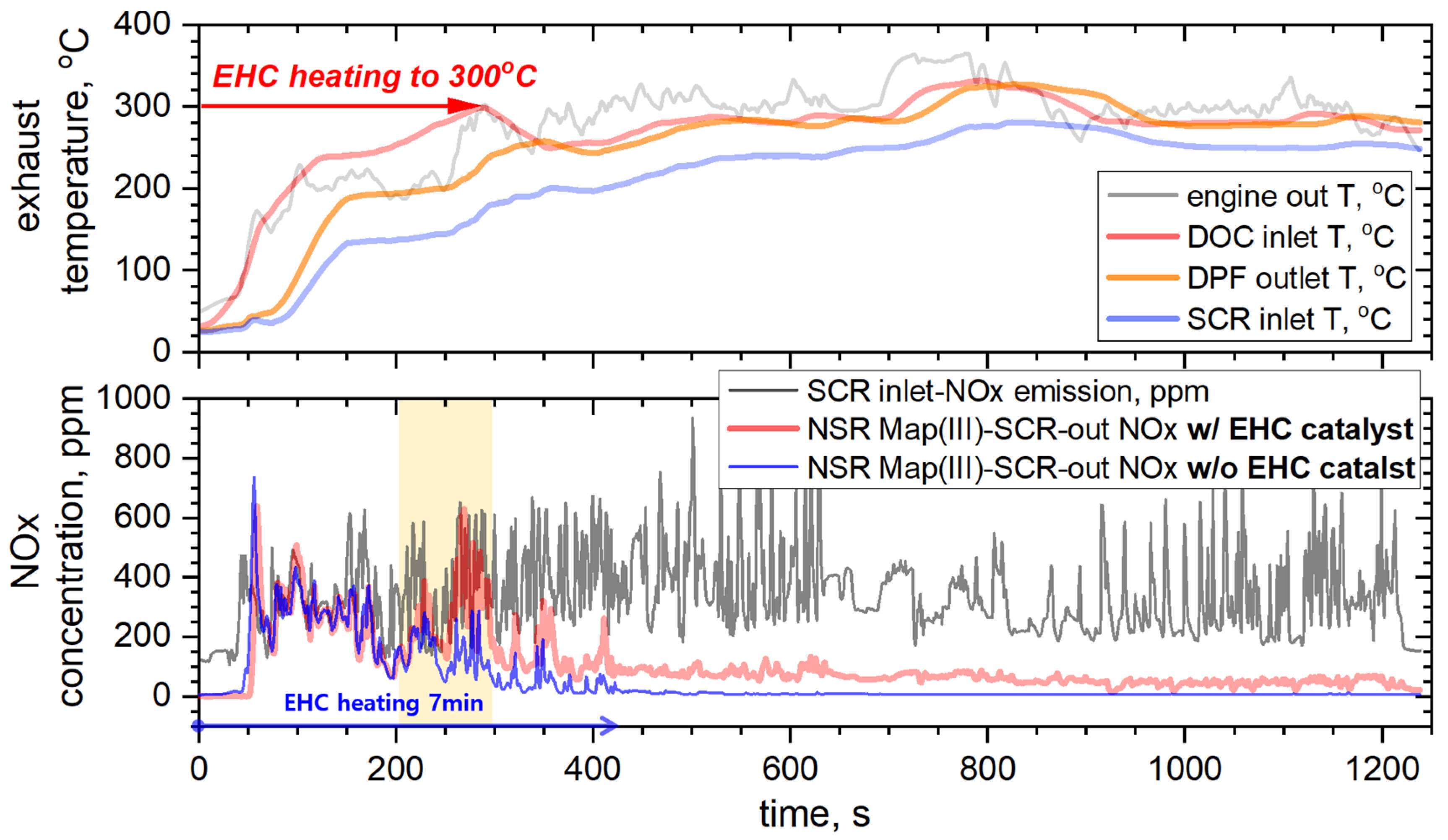

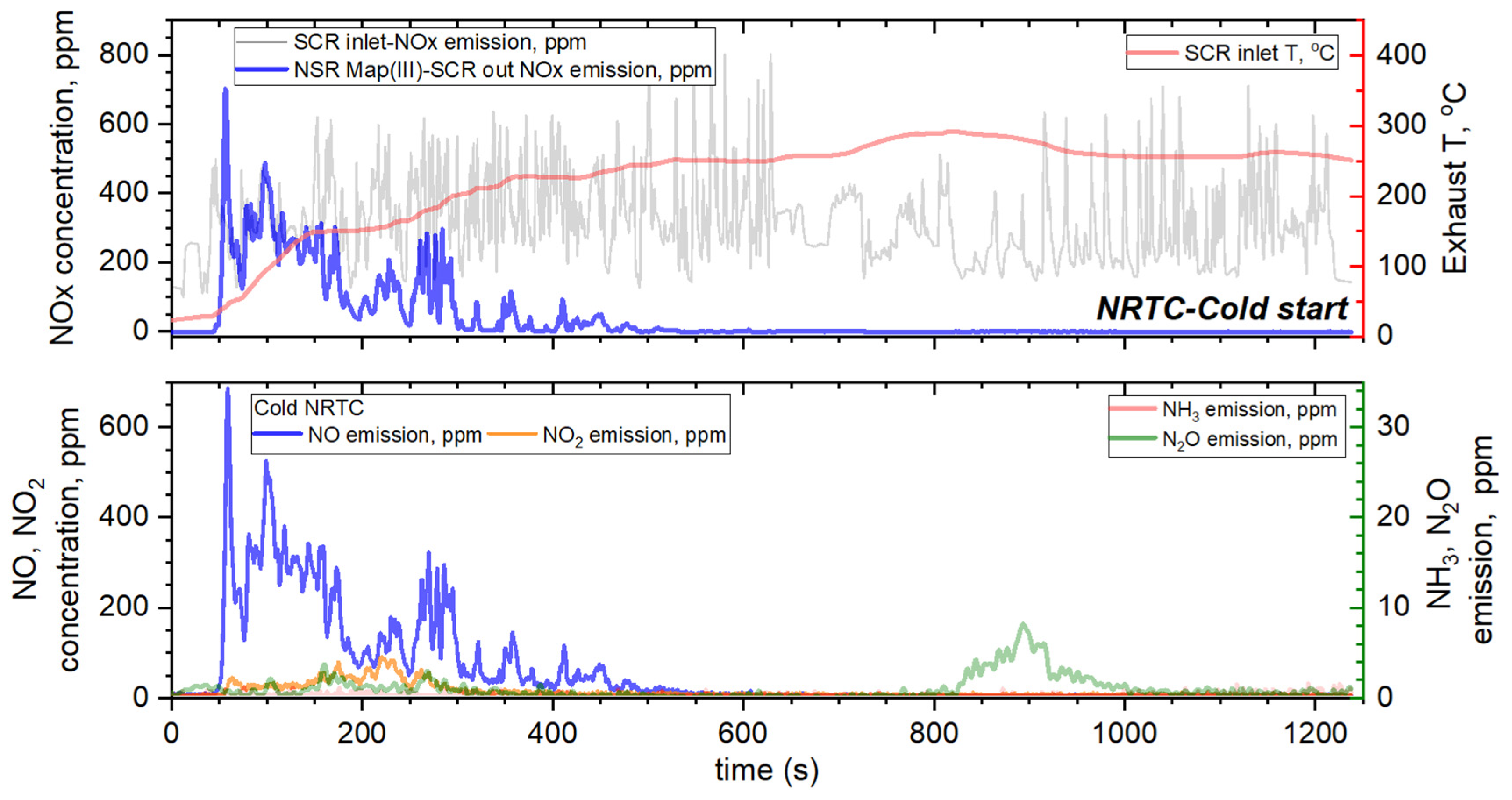

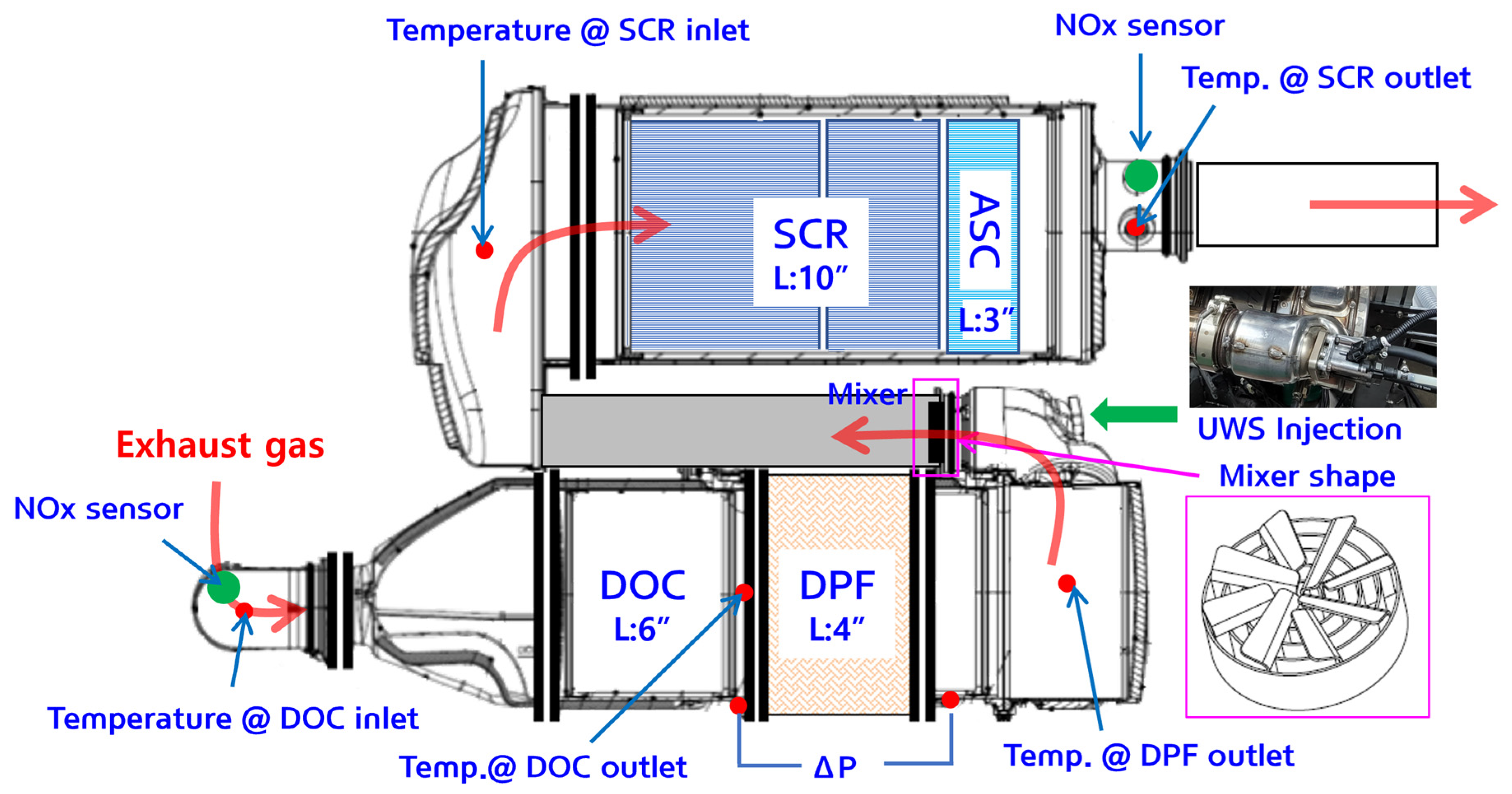
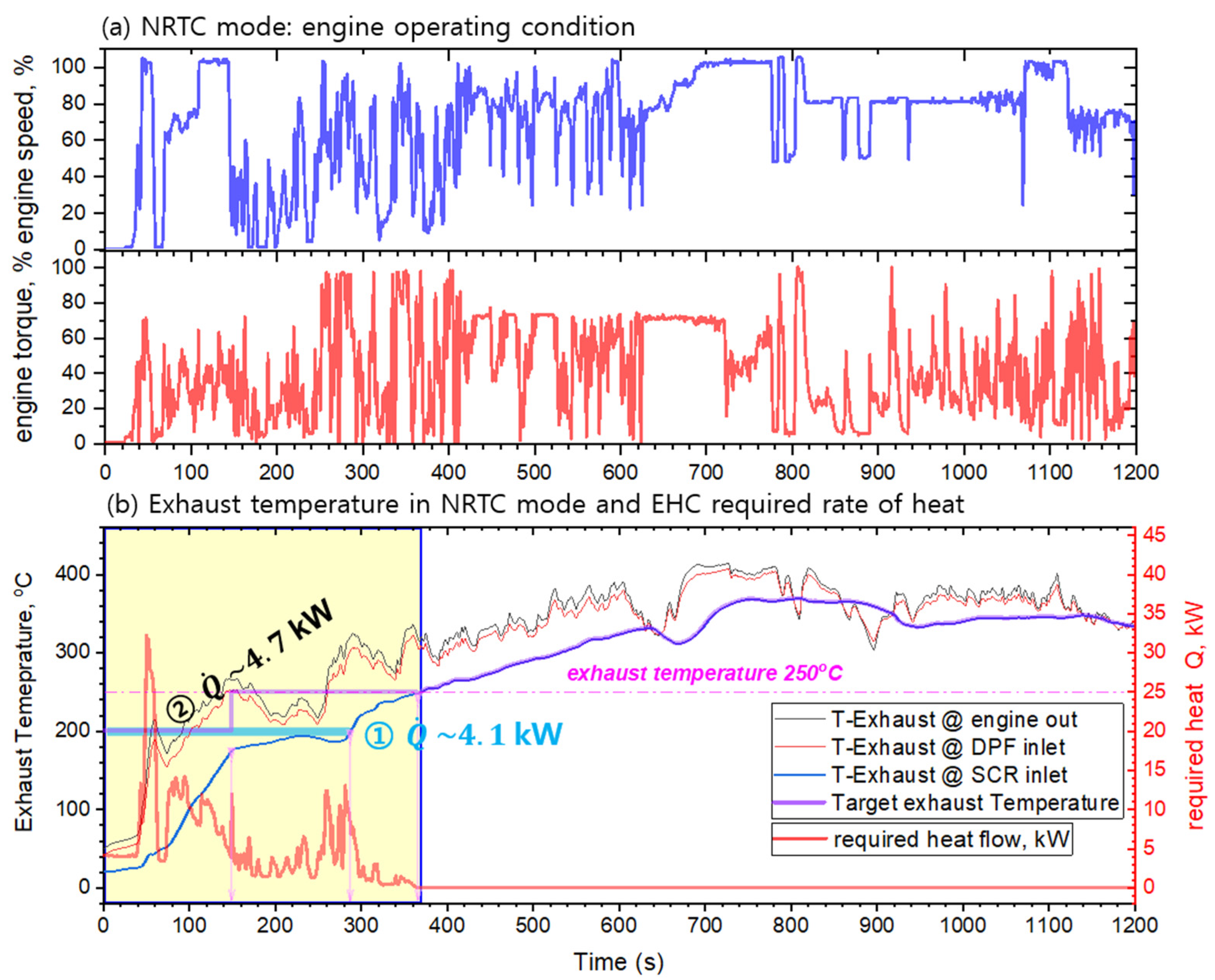
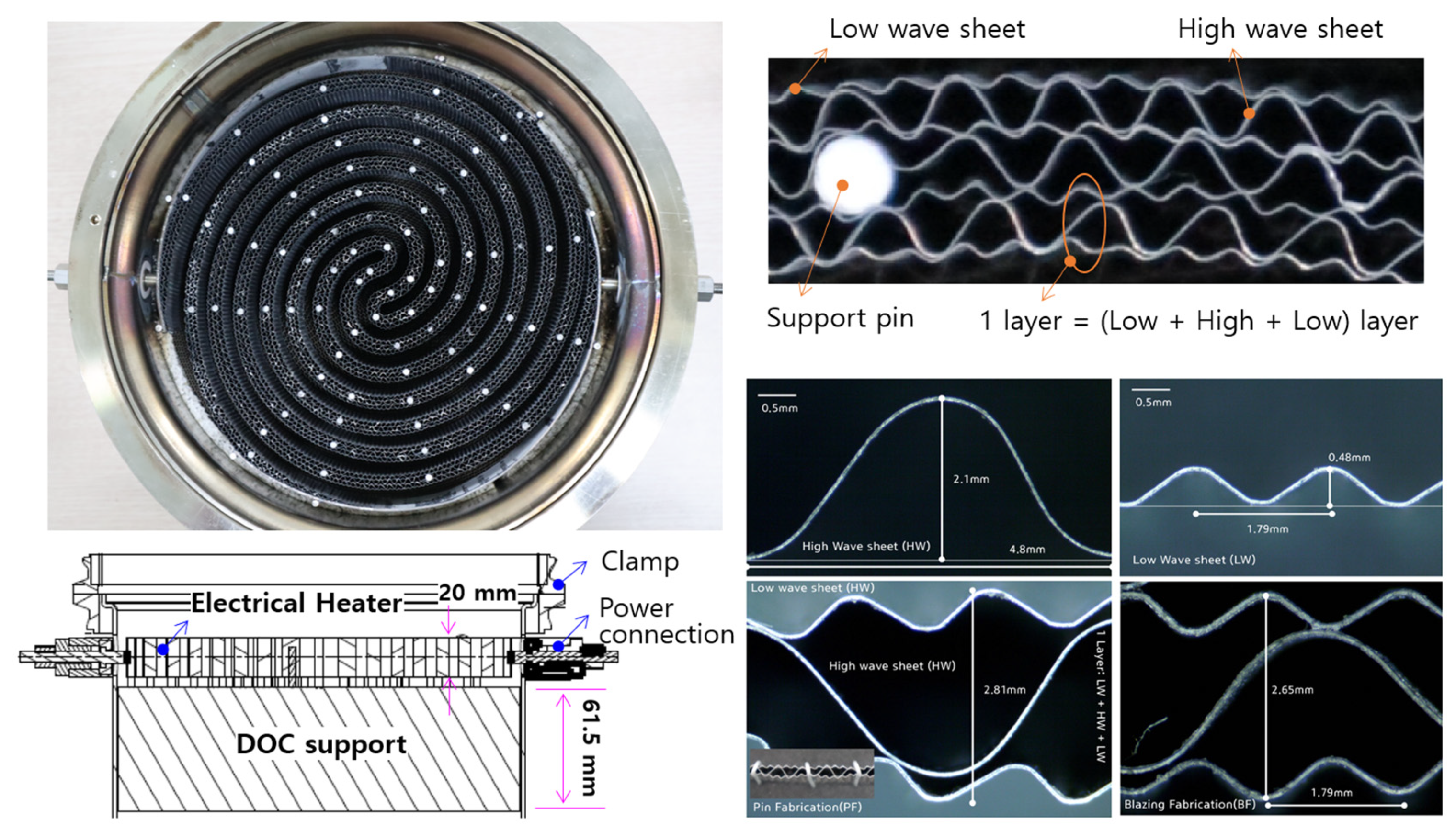
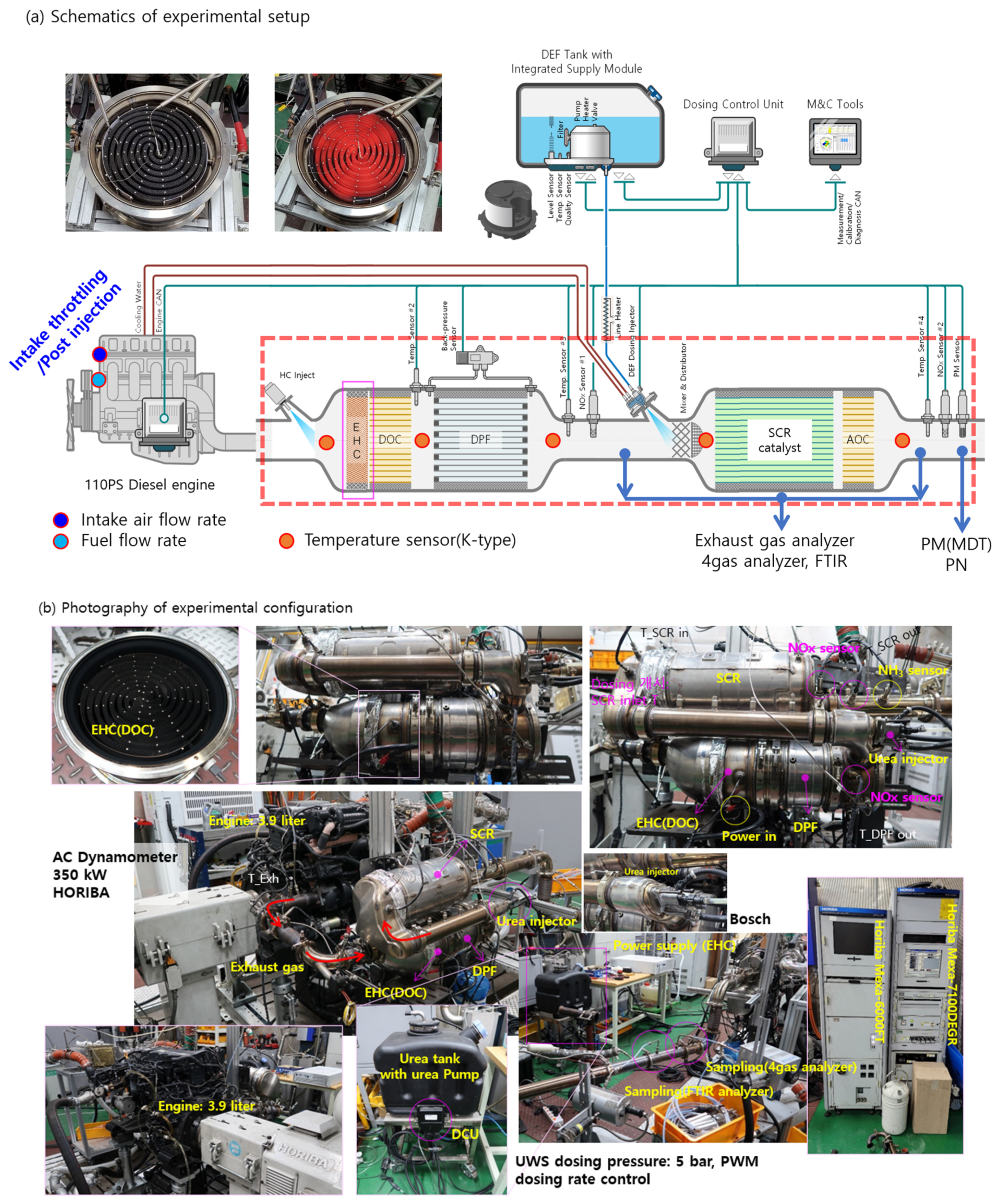
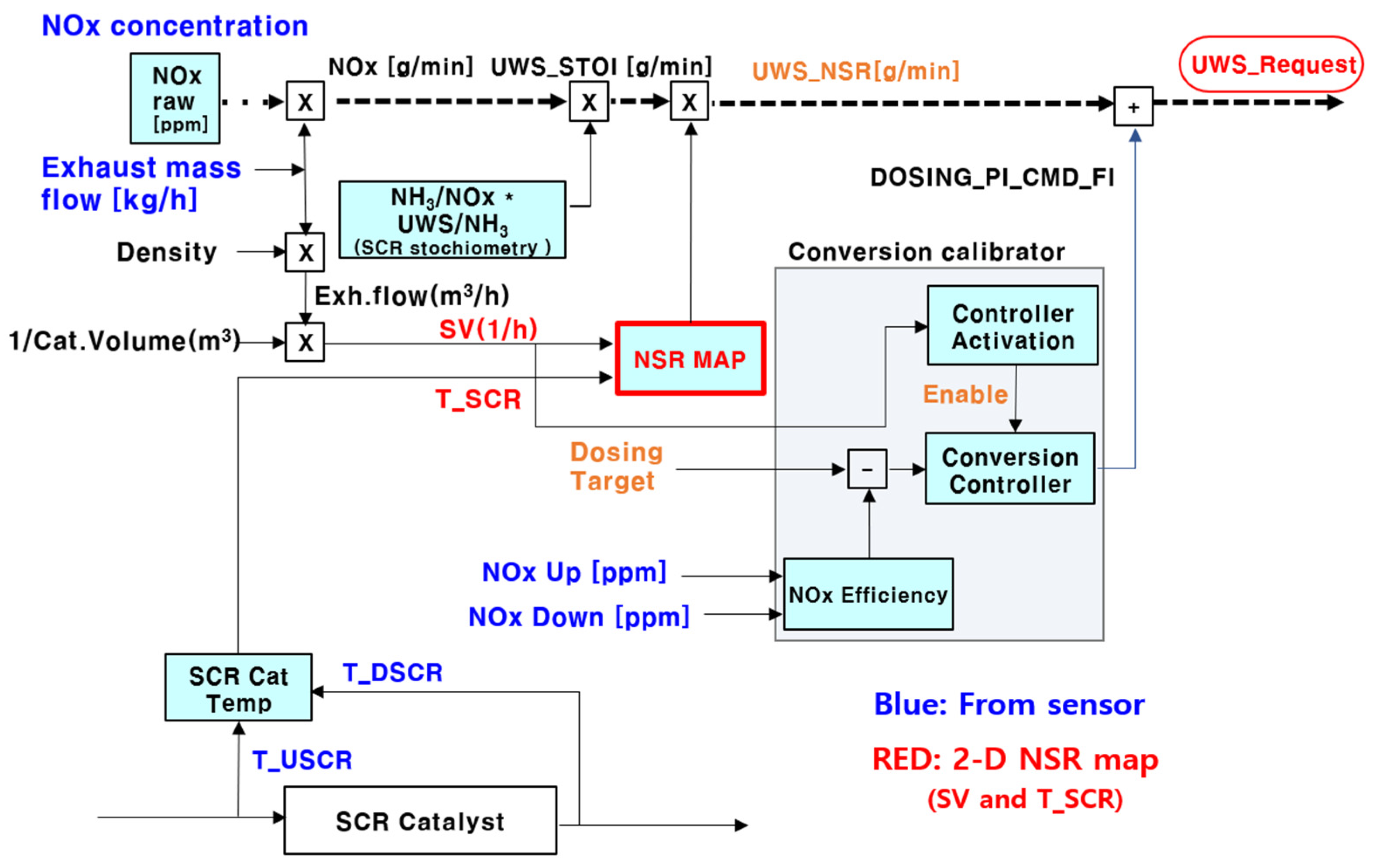
| Category (Thermal Management Tech.) | Post Injection | Burner | Electrical Heated Catalyst |
|---|---|---|---|
| System | Engine: high-pressure multi-injection control with DOC | Burner (ignition, control, and fuel supply) independent of engine | Electrical heater and catalyst-coated substrate |
| Available energy | ++ | +++ | ++ (battery dependent) |
| Fuel penalty | ++ | ++ | +++ |
| Response time | ++ | + | +++ |
| Cost | +++ | + | ++ |
| Durability | ++ | + | ++ |
| Case | Mode–Heating Time | NOx Emission (g/kWh) | PM Emission (g/h) | PM (g/kWh) |
|---|---|---|---|---|
| UWS: NSR map (III) | Cold start–5 min | 1.364 | 0.248 | 0.0091 |
| Hot start–7 min | 0.304 | 0.266 | 0.0096 | |
| UWS: NSR map (III) + 5% | Cold start–5 min | 0.795 | 0.282 | 0.0104 |
| Hot start–7 min | 0.170 | 0.390 | 0.0142 | |
| Stage V regulation | - | 0.400 | - | 0.0150 |
| Case | Mode–Heating Time | NOx Emission (g/kWh) | Fuel Consumption (kg/kWh) | EHC Energy (kWh) | Fuel Penalty (%) |
|---|---|---|---|---|---|
| EHC 3 kW NRTC mode | Cold start–6 min | 0.534 (58.6%) * | 0.261 | 0.3 | 3.01% |
| Hot start–3 min | 0.121 (88.4%) * | 0.253 | 0.15 | 1.53% | |
| Mode result | Cold:Hot = 1:9 | 0.162 (84.8%) * | 0.254 | 0.165 | 1.68% |
| Category | Specification | ||||
| Engine | Engine type | 4 stroke, In-line 4 cylinders, CRDI | |||
| Fuel | Diesel | ||||
| Displacement | 3933 cc | ||||
| Max. power (PS/rpm) | 110/2250 | ||||
| Max. torque (kg∙m/rpm) | 42/1600 | ||||
| EGR | HP-cooled EGR | ||||
| Aftertreatment system | |||||
| DOC | DPF | SCR | ASC | ||
| Diameter, mm | 203.2 (8″) | 203.2 (8″) | 203.2 (8″) | 203.2 (8″) | |
| Length, mm | 101.6 (6″) | 101.6 (4″) | 177.8 (7″) + 101.6 (4″) | 76.2 (3″) | |
| Volume, L | 4.94 | 3.29 | 5.77 + 3.29 | 2.47 | |
| CPSI | 400/4 | SiC, 200/12 | 400/4 | 400/4 | |
| Catalyst | Pt-Pd/Al2O3 | Pt-Pd/Al2O3 | Cu/SSZ-13 | - | |
| Electric Heater | Metal Substrate | |
|---|---|---|
| Diameter (mm) | 190 | 212 |
| Length (mm) | 20 | 30 |
| Power (kW) | 4.4 | - |
| Voltage (V) | 24 | - |
| Cell density (CPSI) | - | 200 |
| Catalyst | - | Pt-Pd/Al2O3 |
Disclaimer/Publisher’s Note: The statements, opinions and data contained in all publications are solely those of the individual author(s) and contributor(s) and not of MDPI and/or the editor(s). MDPI and/or the editor(s) disclaim responsibility for any injury to people or property resulting from any ideas, methods, instructions or products referred to in the content. |
© 2023 by the authors. Licensee MDPI, Basel, Switzerland. This article is an open access article distributed under the terms and conditions of the Creative Commons Attribution (CC BY) license (https://creativecommons.org/licenses/by/4.0/).
Share and Cite
Lee, K.; Lee, J.; Lee, S.; Oh, K.; Jang, S. Fuel Consumption and Emission Reduction for Non-Road Diesel Engines with Electrically Heated Catalysts. Catalysts 2023, 13, 950. https://doi.org/10.3390/catal13060950
Lee K, Lee J, Lee S, Oh K, Jang S. Fuel Consumption and Emission Reduction for Non-Road Diesel Engines with Electrically Heated Catalysts. Catalysts. 2023; 13(6):950. https://doi.org/10.3390/catal13060950
Chicago/Turabian StyleLee, Kyoungbok, Jongin Lee, Sangho Lee, Kwangchul Oh, and Sungwook Jang. 2023. "Fuel Consumption and Emission Reduction for Non-Road Diesel Engines with Electrically Heated Catalysts" Catalysts 13, no. 6: 950. https://doi.org/10.3390/catal13060950
APA StyleLee, K., Lee, J., Lee, S., Oh, K., & Jang, S. (2023). Fuel Consumption and Emission Reduction for Non-Road Diesel Engines with Electrically Heated Catalysts. Catalysts, 13(6), 950. https://doi.org/10.3390/catal13060950






